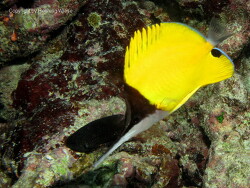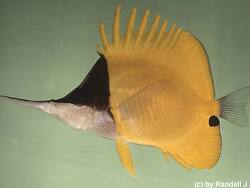Info
(Broussonet, 1782)
Forcipiger longirostris also commonly referred as the Very-long-nose Butterflyfish resembles the Forcepsfish (Forcipiger flavissimus) but can be distinguished by its longer snout, smaller mouth gape, the number of dorsal fin spines (10-11 vs. 12-13 in the Forcepsfish) and by rows of small black spots on the breast. Forcipiger longirostris is widely distributed in Indo-Pacific from East Africa to the Hawaiiian, Marquesan, and Pitcairn islands, north to the Ogasawara Islands, south to New Caledonia and Australia (Northern Great Barrier Reef); throughout Micronesia.
The Very-long-nose Butterflyfish is bright yellow; the upper half of head and nape is almost black, lower part of head and snout is silvery white, has a series of rows of blackish dots on chest; a black spot on anal fin just below base of caudal fin.
Forcipiger longirostris feeds mainly on whole organisms such as small crustaceans and is usually seen in pairs.
Remarks:
Butterflyfish are not recommended for reefs as they will pick at or eat a wide variety of corals, fan worms, and other invertebrates. Most Butterflyfish are known to pick at Aiptaisia, a parasitic anemone.
Synonyms:
Chaetodon longirostris Broussonet, 1782
Chelmo longirostris (Broussonet, 1782)
Forcipiger cyrano Randall, 1961
Forcipiger inornatus Randall, 1961
Prognathodes longirostris (Broussonet, 1782)
Classification: Biota > Animalia (Kingdom) > Chordata (Phylum) > Vertebrata (Subphylum) > Gnathostomata (Superclass) > Pisces (Superclass) > Actinopteri (Class) > Perciformes (Order) > Percoidei (Suborder) > Chaetodontidae (Family) > Forcipiger (Genus) > Forcipiger longirostris (Species)
Forcipiger longirostris also commonly referred as the Very-long-nose Butterflyfish resembles the Forcepsfish (Forcipiger flavissimus) but can be distinguished by its longer snout, smaller mouth gape, the number of dorsal fin spines (10-11 vs. 12-13 in the Forcepsfish) and by rows of small black spots on the breast. Forcipiger longirostris is widely distributed in Indo-Pacific from East Africa to the Hawaiiian, Marquesan, and Pitcairn islands, north to the Ogasawara Islands, south to New Caledonia and Australia (Northern Great Barrier Reef); throughout Micronesia.
The Very-long-nose Butterflyfish is bright yellow; the upper half of head and nape is almost black, lower part of head and snout is silvery white, has a series of rows of blackish dots on chest; a black spot on anal fin just below base of caudal fin.
Forcipiger longirostris feeds mainly on whole organisms such as small crustaceans and is usually seen in pairs.
Remarks:
Butterflyfish are not recommended for reefs as they will pick at or eat a wide variety of corals, fan worms, and other invertebrates. Most Butterflyfish are known to pick at Aiptaisia, a parasitic anemone.
Synonyms:
Chaetodon longirostris Broussonet, 1782
Chelmo longirostris (Broussonet, 1782)
Forcipiger cyrano Randall, 1961
Forcipiger inornatus Randall, 1961
Prognathodes longirostris (Broussonet, 1782)
Classification: Biota > Animalia (Kingdom) > Chordata (Phylum) > Vertebrata (Subphylum) > Gnathostomata (Superclass) > Pisces (Superclass) > Actinopteri (Class) > Perciformes (Order) > Percoidei (Suborder) > Chaetodontidae (Family) > Forcipiger (Genus) > Forcipiger longirostris (Species)







 Dr. Gerry R. Allen, Australien
Dr. Gerry R. Allen, Australien














